Yes! Wonderful - Franciscans of the Immaculate celebrating the Extraordinary Form. Not just that, but they have put together a fantastic video of the Mass with exceptionally beautiful music provided by the Franciscan Sisters of the Immaculate. Benedictines, Dominicans, Cistercians, and Carmelites all have communities that have either recently or long since embraced the Extraordinary Form, espeically in the wake of Summorum Pontificum. Many of these communities have not just celebrated the Mass in the Extraordinary Form, but have fully embraced our Holy Father's theology and teachings about the liturgy that went into his issuing of the Motu Proprio (Continuity of Reform). This strikes me as particularly important as a part of a renewal in some religious communities. When one thinks of the long line of Franciscan Saints, going all the way back to their Seraphic Father Francis, they would have all celebrated or assisted at a Mass that either was the Tridentine Mass, or was something very close to it - in the couple of hundred years before the Council of Trent. The Capuchins would have spent the vast majority of history celebrating this Mass. Saint Padre Pio famously refused to celebrate the Ordinary Form, and some of the last video we have of him, is of him celebrating Mass in the Extraordinary Form. Now a beautiful video once again showing sandled Friars in fiddlebacks...
Hat tip to New Liturgical Movement
























4 comments:
Lovely video but can anyone please tell me (I ask this question everywhere and no one answers) WHY do the acolytes take hold of the celebrant's chausible and hold it away from his body at the consecration? It seems awfully fussy to me.
Patm:
One reason for lifting the chasuble is that it is akin to the ringing of the bells at the concecration in that the acolytes are lifting up the chasuble in order to emphasize what is actually taking place at the consecration.
Specifically, the lifting of the chasuble makes it apparent to us that the graces which flow from the Eucharist flow from Christ through the body of his priest to the faithful sitting and assisting in the pews. The faithful are reminded of this fact every time the priest elevates the consecrated host and the acolytes lift the chasuble. We see Christ at the pinnacle and the priest as his appointed intermediary and through that priest we receive the graces of Christ's most Holy Sacrifice.
I am sure a priest could explain this much better than I, but I Hope my explanation in the least helps explain why the custom is not overly fussy. The more I have learned about the traditional Mass, the more I realize how everything in it has a sound theological and practical reason behind it.
patm,
A good question, to which a definitive answer seems somewhat elusive. I've asked around myself. A Google search will yield some results, but none of them seem to be 100% positive.
The most common answer is that it had to do with either the weight of vestments and assisting the Priest during the elevation, or (and probably most likely) it was an effort to help keep the vestments clean during the genuflections.
Everything in the Mass in the Extraordinary Form (MEF) developed organically over the centuries. Most of the movements and gestures developed for deep spiritual and theological reasons, but some things came about from purely practical beginnings. Over time some of these things simply became part of the ritual of the Mass and lost connection with their origin. The origin in this case was most likely practical. Keep in mind that things like paved roads, modern textiles, washing machines and dry cleaning did not exist in most places throughout the world until about 50 or 60 years ago. Vestments were (are) expensive and getting them cleaned would have been difficult. The utmost care would have been shown to keep them in order. Now think of the fact that a priest walking on dirt streets, even muddy roads, could very easily ruin his vestments when he genuflected throughout the Mass. For this reason it would have been helpful for the altar server to lift the back of the chasuble to keep it off the dirty floor and his shoes. Eventually the true practical foundation of this gesture lost importance and it would begin to take on a more spiritual and theological reasoning, the most common being that it creates a symbolic “arc of grace” or a “grace ramp” flowing down from the Eucharist, through the Celebrant and out to the congregation.
Unfortunately, today many say that these are "superfluous liturgical accretions" that became attached to the Liturgy that, like so many barnacles on a ship, were “thankfully” stripped from the Mass in the Ordinary Form. I couldn't disagree more.
During our Holy Father's visit to Washington, DC, I had another opportunity to visit the Tomb of the Unknown at Arlington National Cemetery. These tombs draw tens of thousands, if not hundreds of thousands, of visitors every year. However most are not there (at least not initially) for the unknown soldiers buried in the tombs, but for the soldiers who have "guarded" these tombs day and night, through severe weather of all kinds, without ceasing since their watch first began. Are these soldiers really guarding the tombs? No. Do they really need to always take 21 steps, stop, turn, wait 21 seconds, turn again, wait 21 seconds, and take 21 steps, repeating this over and over and over again 24/7 without ceasing? Are their rifles even loaded? (answer: no) Do they have to walk in such a strange manner? What's the point really? Couldn't they just walk casually and kind of "hang out"? Do they really have to dress exactly the same down to the wearing the same sunglasses? Do they really have to have such a HIGHLY orchestrated "changing of the guard"? (If you've never been there, do a search on Youtube and watch the changing of the guard.) Is the sergeant of the guard really inspecting their rifles? What ever the answer, the reality is that thousands of people stand in perfect silence, awe and reverence watching the precision rituals of these honor guards, and that most of them probably turn there attention to the reason for these soldiers discipline – honoring these unknown soldiers who gave their lives in defense of our nation. The outward exposition points to an inward disposition.
My point is that rather than seeing this liturgical action as being "fussy", it could be seen as a small part of an extremely rich tradition that developed over hundreds of years and comes together in all of its various parts around the central mystery of the Eucharist in order to convey a profound sense of awe and reverence for Our Lord.
So while lifting the chasuble during the elevation of the Body of Christ is certainly not critical to the validity of Sacrament itself, it is a unique part of our Catholic tradition faithfully handed down through the centuries. In fact many of the things in the Mass, even the Mass in the Ordinary Form, are not critical in and of themselves, but do we really want to strip the Mass of all its liturgical traditions? Where would we stop? With regards to vestments, many didn’t stop at eliminating this one gesture of lifting the chasuble. By the 1980’s many priests had abandoned the chasuble altogether, saying that it too was an unnecessary part of the Mass, saying that the stole alone was enough. To some extent they are correct. The validity of the sacrament is not contingent on whether the priest is wearing a chasuble, but again, where would it stop? Thankfully, in that regard, the Church has spoken and at least made it clear that the celebrating priest must wear a chasuble with the stole UNDERNEATH the chasuble. Now if we could only universally restore more of the reverence previously demonstrated at the Holy Sacrifice of the Altar.
Stephen,
Good catch. I may have mispoken on that one. I was thinking specifically of the Cistercians at Stift Heiligenkruez in Austria. From the pictures (fiddlebacks) and their use of gregorian chant I assumed they celebrated the Extraordinary Form. I also noticed that they list on their weekly schedule a Solemn Mass. However, I'm really not sure since I don't read German. Perhaps you know? If not it seems that they have fully embraced the reform of the reform which would also be wonderful. If you don't know, I'll send one of the monks I have been in contact with an email and try to find out.
Thanks for your prayerful support of my efforts on the blog. Be assured of mine in return.
Post a Comment